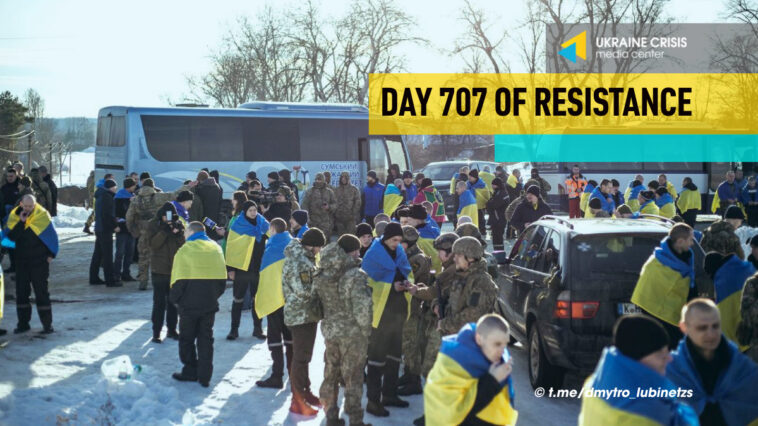Ukraine will receive ground-launched small diameter bombs, the Pentagon confirms. Ukraine returns 207 service members in prisoner swap with Russia. Ukrainian government submits to Parliament amended version of mobilization bill. Here are its highlights.
Ukraine to receive ground-launched small diameter bombs, Pentagon confirms
Ukraine will receive its first batch of ground-launched small diameter bombs, Pentagon press secretary Maj. Gen. Pat Ryder told a news conference on Tuesday. He refrained from specifying the timelines.
“As far as the small diameter bomb, as we acknowledged last year, we will provide Ukraine with the ground-launched small diameter bomb as part of our USAI-funded security assistance efforts [Ukraine Security Assistance Initiative]. However, due to operation security reasons, we’re not going to confirm specific timelines,” Ryder said.
The new bomb, which can travel about 90 miles (approx. 145 km), is expected to be “a significant capability for Ukraine,” a U.S. official who was granted anonymity told Politico. “It gives them a deeper strike capability they haven’t had, it complements their long-range fire arsenal,” the U.S. official said.
The Pentagon has successfully tested a new long-range precision bomb for Ukraine that is expected to arrive on the battlefield as soon as Wednesday, Politico said, citing two U.S. officials and two other people with knowledge of the talks. The Pentagon announced last February that the Biden administration was providing the new bomb to Ukraine.
Ground-launched small diameter bombs are a brand new long-range weapon made by Boeing that even the U.S. doesn’t have in its inventory.
Ukraine will be the first country to use the bomb in combat, making it a critical test case for other countries that have been snapping up long-range munitions since Russia’s invasion of Ukraine in February 2022, Politico said.
Ukraine returns 207 service members in prisoner swap with Russia
Ukraine has returned 207 service members from Russian captivity in a prisoner exchange on Wednesday.
“Our people are back, 207 of them,” Ukrainian President, Volodymyr Zelenskyi said on social media. “We return them home no matter what. We remember each Ukrainian in captivity, both warriors and civilians. We must bring all of them back. We are working on it. Team Ukraine did yet another excellent job. Well done Budanov, Yermak, Usov, Malyuk, and Klymenko!” he said on Telegram.
Ukraine’s Coordination Headquarters for the Treatment of Prisoners of War said 50 prisoner swaps had now taken place since Russia launched its full scale invasion of Ukraine.
Of the 207 liberated service members, 95 are members of the Ukrainian Armed Forces, 56 are from the National Guard, 26 are from the State Border Guard Service, 29 are from the Territorial Defense Force, and one is a member of the National Police.
There were 180 soldiers and sergeants, and 27 officers among the returnees. At least 36 of the Ukrainians released suffered from serious injuries or illnesses, the coordination headquarters said. The oldest Ukrainian service member released has turned 61, and the youngest will soon be 21.
Those released include service members seized in Mariupol, Kherson, and the Zmiyinyi Island, as well as marines and combat medics.
Ukrainian government submits to Parliament amended version of mobilization bill. Here are its highlights
The Ukrainian government submitted to the Parliament on Tuesday an amended version of the mobilization bill.
Outlined below are the key highlights of the bill.
One of the provisions lowers the draft age from 27 to 25 years.
Service terms are to be limited to 36 months during martial law.
The bill proposes to end conscription and introduce five-month “basic military training” for citizens ages 18 to 24. Citizens can choose when to take the training. Employers must grant time off for the training.
Military leave can be split into parts of at least 15 days each. Service members released from captivity are entitled to an additional 90 days of paid leave if they continue to serve.
Draft offices would be able to issue online call-ups to people via an account that citizens would be obliged to have. An account is created based on the “Oberih” single digital register of draft-eligible men.
After mobilization, all people must undergo a compulsory two-three months training before being sent to fight on the frontlines.
Disability is a reason for an exemption from mobilization. Those who mobilized voluntarily have two months to transition to military life.
European security issues among Russian aggression and US challenges. Ukraine in Flames #565
In this episode of Ukraine in Flames we discuss EU security in a period of turbulence and instability, considering the backdrop of Russian aggression and the ongoing election year. The experts agree that EU countries have become more aware of the potential threat, acknowledging the subpar state of their military preparedness for a possible conflict in 2025. Additionally, they underscore the importance for the EU to recognize the strategic value of the Ukrainian army, particularly in light of potential shifts in military policies and the contemplation of an EU-wide military. Take a watch of UIF #565 to find out more.
Guests:
- Yevhen Magda, Director of the Institute of World Policy
- Archil Tsintsadze, security policy expert, security policy expert
- Ihor Seletskyi, Director of the NGO Euro-Atlantic Course

